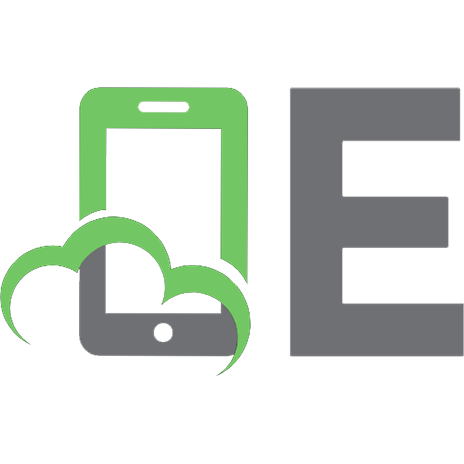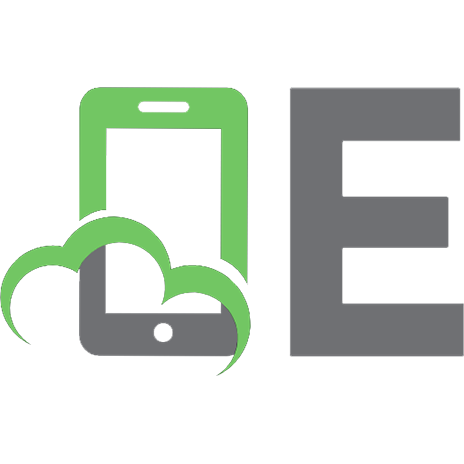Learn WinUI 3: Leverage WinUI and the Windows App SDK to create modern Windows applications with C# and XAML 9781805120063
WinUI 3 takes a whole new approach to delivering Windows UI components and controls and has the ability to deliver the s
130 56 16MB
English Pages 386 Year 2023
Table of contents :
Learn WinUI 3
Contributors
About the author
About the reviewer
Preface
Who this book is for
What this book covers
To get the most out of this book
Download the example code files
Conventions used
Get in touch
Share your thoughts
Download a free PDF copy of this book
Part 1:Introduction to WinUI and Windows Applications
1
Introduction to WinUI
Technical requirements
Before UWP – Windows 8 XAML applications
Windows application UI design
Windows Runtime (WinRT)
User backlash and the path forward to Windows 10
Windows 10 and UWP application development
Language choice with UWP development
Lifting app restrictions
UWP backward compatibility
What is XAML?
Creating an adaptive UI for any device
Powerful data binding
Styling your UI with XAML
Separating presentation from business logic
What is WinUI?
The first WinUI release
The road to WinUI 3
What’s new in WinUI 3?
Goodbye UWP?
New features for WinUI 3 and the Windows App SDK
The Windows App SDK and WinUI
WinUI 3 compared to other Windows development frameworks
WinUI versus UWP
WinUI versus WPF
WinUI versus Windows Forms (WinForms)
Summary
Questions
2
Configuring the Development Environment and Creating the Project
Technical requirements
Installing Visual Studio and Windows desktop development workloads
Introducing the application idea
Reviewing the application features
WinUI in Desktop projects
Creating your first WinUI project
Anatomy of a WinUI in Desktop project
Reviewing App.xaml
Reviewing App.xaml.cs
Reviewing MainWindow.xaml
Reviewing MainWindow.xaml.cs
Reviewing the project references
Reviewing the project properties
XAML basics
Building the model
Creating sample data
Building the initial UI
Completing the data-binding initialization
Creating the DataTemplate and binding the UI
Understanding WinUI and Windows App SDK
Understanding the .NET app model
Working with WinUI controls, properties, and events
Adding a ListView header
Creating the ComboBox filter
Adding a new item button
Summary
Questions
3
MVVM for Maintainability and Testability
Technical requirements
Understanding MVVM
MVVM – the big picture
MVVM libraries for WinUI
The MVVM Toolkit
The Prism Library
MVVMCross
Choosing a framework for WinUI applications
Understanding data binding in WinUI
What are markup extensions?
Binding markup extension
x:Bind markup extension
Updating View data with INotifyPropertyChanged
Updating collection data with INotifyCollectionChanged
Implementing MVVM in WinUI applications
Working with events and commands
Implementing ICommand
Using commands in the View Model
Updating the View
Leveraging the MVVM Toolkit
Summary
Questions
4
Advanced MVVM Concepts
Technical requirements
Understanding the basics of DI
Using DI with ViewModel classes
Leveraging x:Bind with events
Page navigation with MVVM and DI
Migrating MainWindow to MainPage
Adding ItemDetailsPage
Adding new interfaces and services
Creating a navigation service
Creating a data service
Increasing maintainability by consuming services
Handling parameters in ItemDetailsPage
Creating the ItemDetailsViewModel class
Summary
Questions
5
Exploring WinUI Controls
Technical requirements
Understanding what WinUI offers developers
Animated visual player (Lottie)
Navigation View
Parallax view
Rating control
Exploring the WinUI 3 Gallery app for Windows
Learning about the ScrollViewer control
Reviewing what’s new in WinUI 3 and the Windows App SDK
Backward compatibility
Fluent UI and modern look and feel
Visual Studio tooling
The WebView2 control
What’s new in the Windows App SDK
Adding some new controls to the project
Using the SplitButton control
Adding a TeachingTip control to the Save button
Summary
Questions
6
Leveraging Data and Services
Technical requirements
Managing application state with app lifecycle events
Exploring Windows application lifecycle events
Lifecycle events of WinUI applications
Additional lifecycle events with FrameworkElement objects
Creating a SQLite data store
What is SQLite?
Adding SQLite as a data service
Leveraging a Micro ORM to simplify data access
Adding Dapper to the project
Updating the data service’s initialization
Retrieving data via services
Summary
Questions
Part 2:Extending WinUI and Modernizing Applications
7
Fluent Design System for Windows Applications
Technical requirements
What is the Fluent Design System?
Exploring Fluent Design for Windows
Controls
Patterns
Layout
Input
Style
Incorporating Fluent Design in WinUI applications
Updating the title bar
Changing the style of MainPage
Changing the style of ItemDetailsPage
Using the Fluent XAML Theme Editor
Colors
Shapes
Acrylic material and the Fluent Design System
Use Mica in WinUI applications
Incorporate Mica into My Media Collection
Design resources and toolkits for Fluent Design
Summary
Questions
8
Adding Windows Notifications to WinUI Applications
Technical requirements
Overview of push notifications in the Windows App SDK
Raw push notifications
Cloud-based app notifications
Local app notifications
Using raw push notifications in WinUI applications
Adding Windows app notifications with the Windows App SDK
Summary
Questions
9
Enhancing Applications with Community Toolkits
Technical requirements
Introducing the WCT
Origins of the WCT
Reviewing recent toolkit releases
Exploring the WCT Gallery app
Installing and launching the app
Controls
Using controls from the toolkit
Creating the WinUI project
Referencing WCT packages
Adding data to the DataGrid control
Adding controls to the MainWindow control
Exploring the toolkit’s helpers, services, and extensions
Helpers
Extensions
.NET Community Toolkit features
Summary
Questions
10
Accelerating App Development with Template Studio
Technical requirements
Overview of Template Studio for WinUI
Starting a new WinUI project with Template Studio
Exploring the code generated by Template Studio
Exploring the Core project
Exploring the main project
Exploring the MSTest project
Template Studio extensions for other UI frameworks
Template Studio for WPF
Template Studio for Uno Platform
Summary
Questions
Part 3:Build and Deploy on Windows and Beyond
11
Debugging WinUI Applications with Visual Studio
Technical requirements
Debugging in Visual Studio
Debugging local applications
Debugging remote applications
Common XAML layout mistakes
Improving your XAML with static code analysis
Pinpointing data binding failures
Common mistakes in data binding
Using the XAML Binding Failures window
Debugging live data with Live Visual Tree and Live Property Explorer
Coding with XAML Hot Reload
Debugging with Live Visual Tree and Live Property Explorer
Summary
Questions
12
Hosting a Blazor Application in WinUI
Technical requirements
Getting started with ASP.NET Core and Blazor
A brief history of ASP.NET and ASP.NET Core
What is Blazor?
WebAssembly and client-side .NET development
Creating a Blazor Wasm application
Building a simple application for tracking tasks
Exploring Blazor Wasm deployment options
Deployment options for Blazor Wasm projects
Publishing Blazor to Azure Static Web Apps hosting
Pushing the project to GitHub
Creating an Azure Static Web Apps resource
Publishing an application with GitHub Actions
Hosting your Blazor application in the WinUI WebView2
Summary
Questions
13
Take Your App Cross-Platform with Uno Platform
Technical requirements
An overview of Uno Platform
Creating your first Uno Platform project
Migrating WinUI XAML markup and code to Uno Platform
Migrating the WinUI project code
Migrating the WinUI XAML views
Running on Android with WSA
Running in the browser with WebAssembly
Summary
Questions
14
Packaging and Deploying WinUI Applications
Technical requirements
Discovering application packaging and MSIX basics
MSIX
Reviewing MSIX tools and resources
Packaged applications and application identity
Getting started with application packaging in Visual Studio
Deploying applications with Windows Package Manager
Adding a package to the community repository
Using WinGet for package management
Distributing applications with the Microsoft Store
Preparing a free application for the Microsoft Store
Uploading a package to the Store
Sideloading WinUI applications with MSIX
Creating an MSIX package for sideloading
Sideloading an MSIX package
Summary
Questions
Index
Why subscribe?
Other Books You May Enjoy
Packt is searching for authors like you
Share your thoughts
Download a free PDF copy of this book
Learn WinUI 3
Contributors
About the author
About the reviewer
Preface
Who this book is for
What this book covers
To get the most out of this book
Download the example code files
Conventions used
Get in touch
Share your thoughts
Download a free PDF copy of this book
Part 1:Introduction to WinUI and Windows Applications
1
Introduction to WinUI
Technical requirements
Before UWP – Windows 8 XAML applications
Windows application UI design
Windows Runtime (WinRT)
User backlash and the path forward to Windows 10
Windows 10 and UWP application development
Language choice with UWP development
Lifting app restrictions
UWP backward compatibility
What is XAML?
Creating an adaptive UI for any device
Powerful data binding
Styling your UI with XAML
Separating presentation from business logic
What is WinUI?
The first WinUI release
The road to WinUI 3
What’s new in WinUI 3?
Goodbye UWP?
New features for WinUI 3 and the Windows App SDK
The Windows App SDK and WinUI
WinUI 3 compared to other Windows development frameworks
WinUI versus UWP
WinUI versus WPF
WinUI versus Windows Forms (WinForms)
Summary
Questions
2
Configuring the Development Environment and Creating the Project
Technical requirements
Installing Visual Studio and Windows desktop development workloads
Introducing the application idea
Reviewing the application features
WinUI in Desktop projects
Creating your first WinUI project
Anatomy of a WinUI in Desktop project
Reviewing App.xaml
Reviewing App.xaml.cs
Reviewing MainWindow.xaml
Reviewing MainWindow.xaml.cs
Reviewing the project references
Reviewing the project properties
XAML basics
Building the model
Creating sample data
Building the initial UI
Completing the data-binding initialization
Creating the DataTemplate and binding the UI
Understanding WinUI and Windows App SDK
Understanding the .NET app model
Working with WinUI controls, properties, and events
Adding a ListView header
Creating the ComboBox filter
Adding a new item button
Summary
Questions
3
MVVM for Maintainability and Testability
Technical requirements
Understanding MVVM
MVVM – the big picture
MVVM libraries for WinUI
The MVVM Toolkit
The Prism Library
MVVMCross
Choosing a framework for WinUI applications
Understanding data binding in WinUI
What are markup extensions?
Binding markup extension
x:Bind markup extension
Updating View data with INotifyPropertyChanged
Updating collection data with INotifyCollectionChanged
Implementing MVVM in WinUI applications
Working with events and commands
Implementing ICommand
Using commands in the View Model
Updating the View
Leveraging the MVVM Toolkit
Summary
Questions
4
Advanced MVVM Concepts
Technical requirements
Understanding the basics of DI
Using DI with ViewModel classes
Leveraging x:Bind with events
Page navigation with MVVM and DI
Migrating MainWindow to MainPage
Adding ItemDetailsPage
Adding new interfaces and services
Creating a navigation service
Creating a data service
Increasing maintainability by consuming services
Handling parameters in ItemDetailsPage
Creating the ItemDetailsViewModel class
Summary
Questions
5
Exploring WinUI Controls
Technical requirements
Understanding what WinUI offers developers
Animated visual player (Lottie)
Navigation View
Parallax view
Rating control
Exploring the WinUI 3 Gallery app for Windows
Learning about the ScrollViewer control
Reviewing what’s new in WinUI 3 and the Windows App SDK
Backward compatibility
Fluent UI and modern look and feel
Visual Studio tooling
The WebView2 control
What’s new in the Windows App SDK
Adding some new controls to the project
Using the SplitButton control
Adding a TeachingTip control to the Save button
Summary
Questions
6
Leveraging Data and Services
Technical requirements
Managing application state with app lifecycle events
Exploring Windows application lifecycle events
Lifecycle events of WinUI applications
Additional lifecycle events with FrameworkElement objects
Creating a SQLite data store
What is SQLite?
Adding SQLite as a data service
Leveraging a Micro ORM to simplify data access
Adding Dapper to the project
Updating the data service’s initialization
Retrieving data via services
Summary
Questions
Part 2:Extending WinUI and Modernizing Applications
7
Fluent Design System for Windows Applications
Technical requirements
What is the Fluent Design System?
Exploring Fluent Design for Windows
Controls
Patterns
Layout
Input
Style
Incorporating Fluent Design in WinUI applications
Updating the title bar
Changing the style of MainPage
Changing the style of ItemDetailsPage
Using the Fluent XAML Theme Editor
Colors
Shapes
Acrylic material and the Fluent Design System
Use Mica in WinUI applications
Incorporate Mica into My Media Collection
Design resources and toolkits for Fluent Design
Summary
Questions
8
Adding Windows Notifications to WinUI Applications
Technical requirements
Overview of push notifications in the Windows App SDK
Raw push notifications
Cloud-based app notifications
Local app notifications
Using raw push notifications in WinUI applications
Adding Windows app notifications with the Windows App SDK
Summary
Questions
9
Enhancing Applications with Community Toolkits
Technical requirements
Introducing the WCT
Origins of the WCT
Reviewing recent toolkit releases
Exploring the WCT Gallery app
Installing and launching the app
Controls
Using controls from the toolkit
Creating the WinUI project
Referencing WCT packages
Adding data to the DataGrid control
Adding controls to the MainWindow control
Exploring the toolkit’s helpers, services, and extensions
Helpers
Extensions
.NET Community Toolkit features
Summary
Questions
10
Accelerating App Development with Template Studio
Technical requirements
Overview of Template Studio for WinUI
Starting a new WinUI project with Template Studio
Exploring the code generated by Template Studio
Exploring the Core project
Exploring the main project
Exploring the MSTest project
Template Studio extensions for other UI frameworks
Template Studio for WPF
Template Studio for Uno Platform
Summary
Questions
Part 3:Build and Deploy on Windows and Beyond
11
Debugging WinUI Applications with Visual Studio
Technical requirements
Debugging in Visual Studio
Debugging local applications
Debugging remote applications
Common XAML layout mistakes
Improving your XAML with static code analysis
Pinpointing data binding failures
Common mistakes in data binding
Using the XAML Binding Failures window
Debugging live data with Live Visual Tree and Live Property Explorer
Coding with XAML Hot Reload
Debugging with Live Visual Tree and Live Property Explorer
Summary
Questions
12
Hosting a Blazor Application in WinUI
Technical requirements
Getting started with ASP.NET Core and Blazor
A brief history of ASP.NET and ASP.NET Core
What is Blazor?
WebAssembly and client-side .NET development
Creating a Blazor Wasm application
Building a simple application for tracking tasks
Exploring Blazor Wasm deployment options
Deployment options for Blazor Wasm projects
Publishing Blazor to Azure Static Web Apps hosting
Pushing the project to GitHub
Creating an Azure Static Web Apps resource
Publishing an application with GitHub Actions
Hosting your Blazor application in the WinUI WebView2
Summary
Questions
13
Take Your App Cross-Platform with Uno Platform
Technical requirements
An overview of Uno Platform
Creating your first Uno Platform project
Migrating WinUI XAML markup and code to Uno Platform
Migrating the WinUI project code
Migrating the WinUI XAML views
Running on Android with WSA
Running in the browser with WebAssembly
Summary
Questions
14
Packaging and Deploying WinUI Applications
Technical requirements
Discovering application packaging and MSIX basics
MSIX
Reviewing MSIX tools and resources
Packaged applications and application identity
Getting started with application packaging in Visual Studio
Deploying applications with Windows Package Manager
Adding a package to the community repository
Using WinGet for package management
Distributing applications with the Microsoft Store
Preparing a free application for the Microsoft Store
Uploading a package to the Store
Sideloading WinUI applications with MSIX
Creating an MSIX package for sideloading
Sideloading an MSIX package
Summary
Questions
Index
Why subscribe?
Other Books You May Enjoy
Packt is searching for authors like you
Share your thoughts
Download a free PDF copy of this book

![Learn WinUI 3: Leverage WinUI and the Windows App SDK to create modern Windows applications with C# and XAML [2 ed.]
1805120069, 9781805120063](https://ebin.pub/img/200x200/learn-winui-3-leverage-winui-and-the-windows-app-sdk-to-create-modern-windows-applications-with-c-and-xaml-2nbsped-1805120069-9781805120063.jpg)






